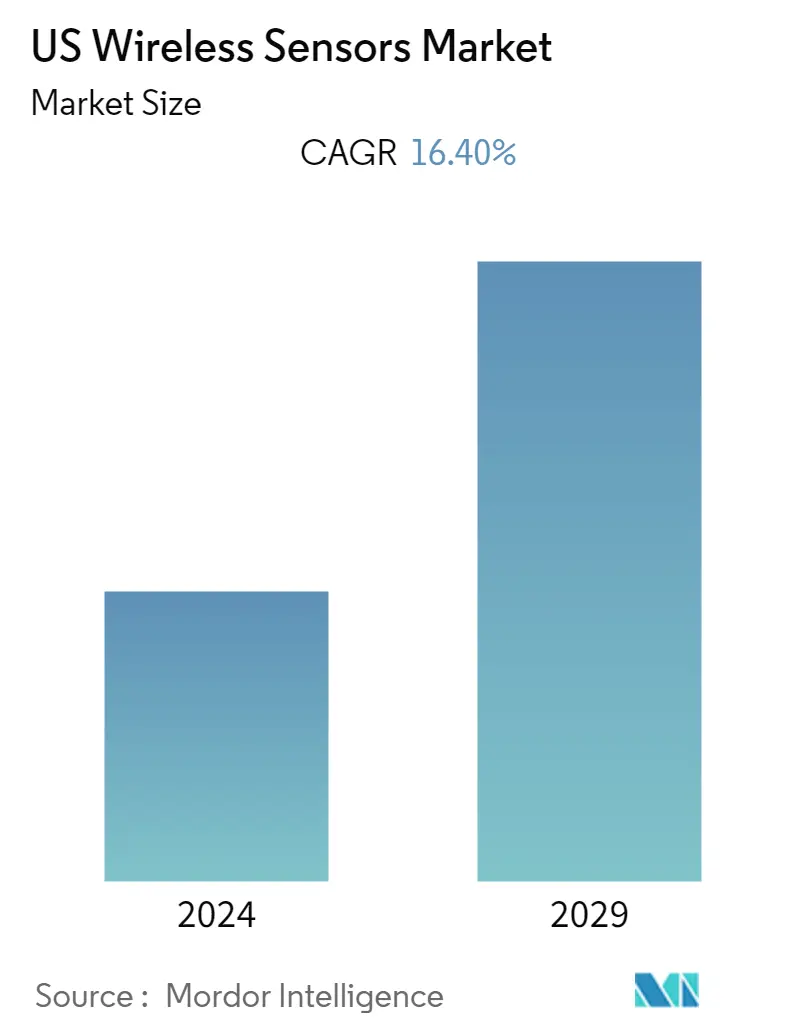Market Size of US Wireless Sensors Industry

| Study Period | 2019 - 2029 |
| Base Year For Estimation | 2023 |
| Forecast Data Period | 2024 - 2029 |
| Historical Data Period | 2019 - 2022 |
| CAGR | 16.40 % |
| Market Concentration | Medium |
Major Players
*Disclaimer: Major Players sorted in no particular order |
US Wireless Sensors Market Analysis
The United States wireless sensor market is expected to register a CAGR of 16.4% during the forecast period (2021 - 2026). The COVID-19 outbreak forced companies worldwide to adjust their strategies to survive in the "new normal." The COVID-19 outbreak affected the various manufacturing industries, resulting in a temporary shutdown of industrial operations. The supply chains ' disruption affected the production of consumer electronics, automotive, healthcare devices, and other sectors, which are prominent adopters of wireless sensors.
- Wireless sensors offer several advantages, such as accuracy and reliability, with the help of various innovative technologies, such as RFID and Bluetooth, in addition to the potential to make electronic devices easy to integrate. As a result, they gained significant traction in the past few years.
- These sensors are primarily used in factory settings for data monitoring of production flow. These also find applications in defense, building automation, and other industries, like materials handling and food and beverage, due to the increasing quest for new energy sources, government regulations, renewable energy development, and rapid technological advancements.
- Due to the increased government regulation in the region for the increased use of the sensor for safety, the demand for wireless sensors is growing. For instance, the areas with challenging environmental conditions, such as extreme high pressure, high temperature, etc. With the help of wireless sensors, it becomes easy to control and monitor the facility from a safe distance continually. They help to acquire the data from locations, which are difficult to access.
- Industry 4.0 revolution, in which machines are becoming more intelligent and intuitive, is increasing the need for the industrial applications of wireless sensors. The new machines are to be designed to be more efficient, safe, and flexible, with the ability to monitor their performance, usage, and failure autonomously. Therefore, these applications spur the demand for highly sensitive sensors.
- The rising adoption of IoT (Internet-of-Things) in the United States is another major factor driving the market's growth. This growth in IoT-connected devices is projected to fuel the demand for wireless sensors.
- Further, transforming the development of smart homes and buildings, smart cities, and smart factories demand the use of wireless sensors, owing to the small form factor, high precision, low power consumption, and ability to control and monitor ambient parameters (such as humidity, pressure, and air quality) in smart homes with the help of wireless technologies.
US Wireless Sensors Industry Segmentation
The study characterizes the wireless sensors market based on the type of wireless sensors and the end-user industry. Wireless sensors are measurement tools for monitoring and recording the physical conditions of the environment. They are equipped with transmitters that convert signals from process control instruments into a radio transmission. These sensors have various applications in numerous sectors, such as automotive, healthcare, aerospace, etc. These have formed the part of the study in considering the end-user industry estimation. Key base indicators considered for the study are adoption and penetration rate in various industries, such as automotive, healthcare, energy and power, aerospace and defense, current trends, and several other key macro-economic indicators.
| By Type | |
| Pressure Sensor | |
| Temperature Sensor | |
| Chemical and Gas Sensor | |
| Position and Proximity Sensor | |
| Other Types |
| By End-user Industry | |
| Automotive | |
| Healthcare | |
| Aerospace and Defense | |
| Energy and Power | |
| Food and Beverage | |
| Other End-user Industries |
US Wireless Sensors Market Size Summary
The United States wireless sensor market is experiencing significant growth, driven by the increasing adoption of IoT technologies and the ongoing Industry 4.0 revolution. These sensors, which utilize advanced technologies like RFID and Bluetooth, are becoming integral in various sectors, including automotive, healthcare, and industrial automation. Their ability to provide accurate and reliable data monitoring is enhancing operational efficiencies and safety across industries. The demand for wireless sensors is further bolstered by government regulations promoting safety and the need for remote monitoring in challenging environmental conditions. As smart homes, cities, and factories continue to evolve, the small form factor and low power consumption of wireless sensors make them ideal for controlling and monitoring ambient parameters.
In the automotive sector, wireless sensors are being increasingly integrated to improve vehicle performance and safety features. Companies are developing innovative solutions, such as wireless charging technologies and infrared tire temperature measurements, to meet the growing demand for advanced sensor applications. The market is moderately fragmented, with key players focusing on product innovation and expanding their global presence. Recent developments, such as the creation of wireless sensor networks for disease surveillance and precision agriculture, highlight the diverse applications and ongoing advancements in this field. As the market continues to expand, the competitive landscape remains dynamic, with companies striving to enhance their product offerings and capture a larger market share.
US Wireless Sensors Market Size - Table of Contents
-
1. MARKET INSIGHTS
-
1.1 Market Overview
-
1.2 Industry Value Chain Analysis
-
1.3 Industry Attractiveness - Porter's Five Forces Analysis
-
1.3.1 Bargaining Power of Suppliers
-
1.3.2 Bargaining Power of Consumers
-
1.3.3 Threat of New Entrants
-
1.3.4 Threat of Substitutes
-
1.3.5 Intensity of Competitive Rivalry
-
-
1.4 Technology Snapshot
-
1.5 Impact of COVID-19 on the market
-
-
2. MARKET SEGMENTATION
-
2.1 By Type
-
2.1.1 Pressure Sensor
-
2.1.2 Temperature Sensor
-
2.1.3 Chemical and Gas Sensor
-
2.1.4 Position and Proximity Sensor
-
2.1.5 Other Types
-
-
2.2 By End-user Industry
-
2.2.1 Automotive
-
2.2.2 Healthcare
-
2.2.3 Aerospace and Defense
-
2.2.4 Energy and Power
-
2.2.5 Food and Beverage
-
2.2.6 Other End-user Industries
-
-
US Wireless Sensors Market Size FAQs
What is the current US Wireless Sensors Market size?
The US Wireless Sensors Market is projected to register a CAGR of 16.40% during the forecast period (2024-2029)
Who are the key players in US Wireless Sensors Market?
Honeywell International Inc., Emerson Electric Co., Texas Instruments Incorporated, ABB Ltd and Pasco Scientific are the major companies operating in the US Wireless Sensors Market.

